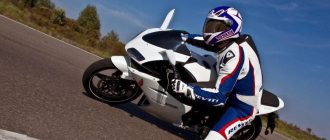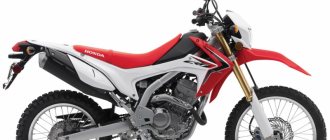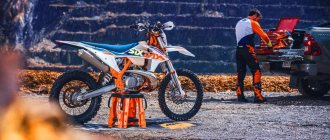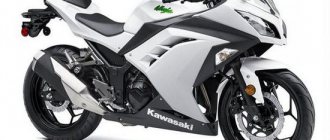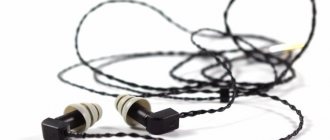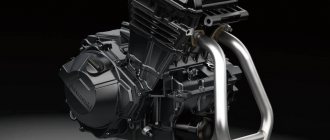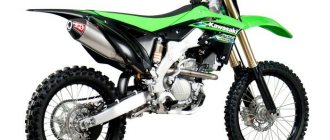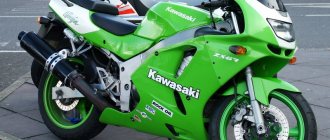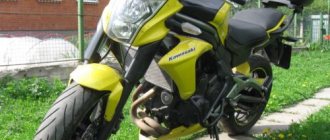MY MOTORCYCLE
Engine: 599 cm3, RA, 16v, DOHC, F Power: 126 hp at UOOO rpm Torque: 67 Nm at 11800 rpm Weight: 191 kg
The 2009-2012 ZX-6R is the first production motorcycle to be equipped with the revolutionary Showa BPF fork. At the time it entered the market, it was equipped with, in fact, the most sophisticated front suspension among Japanese and European competitors. It is noteworthy that the Showa Corporation is controlled by the Honda concern, but Kawasaki became the experimental platform for testing the new suspension. The experiment was more than successful: in 2010, Showa BPF appeared on the Suzuki GSX-R1000, a year later - on all sports six hundred and “liter” Suzuki and Kawasaki. What about Honda? After testing its product on hamsters, the company just this year installed a BPF fork on its CBR1000RR Fireblade. Since thrice-cautious Honda decided to take such a step, it means the suspension is really better than the classic inverted fork.
The first impressions from the motorcycle test are that the front suspension is so sensitive, it’s as if the rider runs his palms along the asphalt, instantly assessing the condition of the surface. On any road, no matter the weather conditions or the quality of the asphalt, the ZX-6R's front suspension carefully records the slightest changes, transmitting them to the pilot.
Here we need to say a few words about the Showa BPF design. This inverted telescopic fork is a fresh “hello” from the MotoGP championship, where it has been successfully used since 2007. Its main difference from classic cartridge inverters is the use of one large piston with compression and rebound valves instead of two small ones, responsible for compression and rebound separately. This is where the name of the product comes from - Big Piston Fork. An increase in the size of the piston and the sections in it responsible for compression and rebound damping means that the rate of oil flow in the fork decreases, the accuracy of suspension damping at high and low speeds increases, and the hydraulic locking effect disappears.
Unlike some European and Japanese competitors, the Ninja is devoid of fancy electronic features such as a choice of injection maps, ABS and traction control systems. With such an advanced fork, she doesn't need them. The feel of the front suspension is comparable to the fine filter of the latest traction control on the rear wheel. This means that even a novice pilot can easily and naturally control the moment the front wheel loses traction with the asphalt, both during braking and when entering a turn.
The effect of the new fork would not be complete without a thorough modification of the chassis and engine of the motorcycle. The seriously updated 599 cc in-line engine produces 126 hp. at 14,000 rpm (claimed) - more than any competitor in the 600 cc super sports class. The rigidity of the aluminum frame has increased, and the geometry of the steering column has become sharper. To prevent the steering wheel from wobbling at speed, an Ohlins damper was added as stock. The wheelbase was slightly reduced, a cassette gearbox and a slipper clutch appeared. Ninja needed such a serious upgrade for a long time. Since 2007, Kawasaki has removed the 636th Ninja from its lineup, which was beloved by customers and provided the “green” with high sales around the world. The popularity of the ZX-6R began to decline due to a change in the engine, which was inserted into a heavier chassis. The motorcycle was also inferior to its competitors: in technical terms - Yamaha YZF-R6, in sales - Honda CBR600RR. After testing the new version of the ZX-6R at the Alee circuit in France, we are convinced that the super sports motorcycle segment is once again led by the “greens”! This is confirmed by the results of the WorldSSP World Championship. At the end of the 2008 season with the old version of Ninja, Kawasaki took a shameful 16th place. In 2009, the pilot of the “green” team, Joan La Score, took fourth place, and since the 2010 season, Kawasaki has been consistently in the top three of the world championship. This year the plant has every chance to take gold: Kawasaki pilot Kenan Sofuoglu is leading the WorldSSP with a good lead over the competitors.
1. The instrument panel is similar to the instrument panel of the 2008-2010 generation ZX-10R model. The only innovation is the 2nd gear engaged indicator. The spring preload is adjusted using a ring at the end of the BPF fork. The compression and rebound damping settings have been moved to the upper crossbar 3. The new throttle drive mechanism is 30 g lighter 4. Passenger comfort has worsened: the seat is firmer, 50 mm narrower and 5 mm higher from the ground 5. The new rear brake pedal is installed on the same axis with kickstand 6. The slipper clutch housing cover is made of magnesium, which saves 610g of weight. The expansion tank for the rear brake circuit 7 is hidden above it. The brake light does not fit perfectly with the scarf parts framing it.
8. The rear brake disc has increased in diameter from 210 to 220 mm
Thanks to the new front suspension, the ZX-6R corners easier and handles uneven pavement more stable, remaining stable and agile at any speed. Credit must be given to the Pirelli Dragon Supercorsa Pro tires (front SC1, rear SC2) on which the test bike is shod. These tires will allow the Ninja to handle tight corners much better than before.
9. The LAP button on the left handlebar is designed to record the lap time (there is such a function in the instrument panel) 10. The monoshock absorber remains the same, only the length of its working stroke has increased (by 1 mm). As in the previous version of the 600, adjustments are available for compression damping (high- and low- speed), rebound damping (25-step), and spring preload. 11. The distance between the passenger footrests and the seat level has decreased by 10 mm. “Number two” will now have to bend his knees more. The swingarm design is similar to the older Ninja 12. As on the sports 600s from Suzuki and Yamaha, the Kawasaki exhaust is located below the engine, and not under the seat, as before. This provides benefits both in terms of weight distribution and design.
It is important that the pilot gains full control of the motorcycle from the first seconds. The seating position has been slightly changed compared to the Ninja '08; it is comfortable, natural and does not require extra effort when driving. By changing the ergonomics, Kawasaki designers were guided by the standards of the WorldSSP world championship. Thus, the handlebars are located 30 mm further from the pilot’s seat, which increases the load on the hands. Smarter shallow tank recesses make it easier for the pilot to move when turning. The seat is somewhat deep, which allows the rider to “merge” with the motorcycle on a straight line, lying on the tank while passing high-speed straights. Ninja is tailored for the track, it is here, and not outside in the city or in a long distance, that she feels at ease. Ninja's bias towards high athletic standards can go sideways if your height is above average. At high speed there is turbulence in the shoulder area. The previous version of the ZX-6R had almost sport-tourer-like wind protection.
Another disadvantage of the Ninja is the height of the footpegs. They have been raised and brought 25mm closer to the driver's seating level, but this is not enough for active track driving. Even if you don't park the bike until the sparks fly out from under the pegs, you will still have to move your feet to avoid the toes of your boots rubbing on the asphalt.
In addition to maneuverability, the jerk and acceleration of the 4-cylinder in-line engine is impressive. Like the chassis, the engine received many changes: new intake ducts; a different piston profile and a molybdenum coating on their skirts, which reduces friction; lightweight drive chain. Improved performance in the mid and high operating ranges. The tachometer is marked up to an incredible 20,000 rpm, but already at 16,500 the cutoff is triggered.
In 2009, when the new sixth Ninja was released, confusion arose in the ranks of the “greens”. The Japanese considered the design of the current ZX-10R so successful that they decided to copy it to the new six hundred in the smallest detail. Until the 2011 season, when a completely new “ten” was released, these sportbikes could only be distinguished by the numbers 6 and 10 on the fairing. Such unification is common in Europe, but not in Japan. In order to save money, Western motorcycle manufacturers often produce motorcycles that are as similar as two peas in a pod with engines of different sizes. In particular, Ducati, Venelli and MV Agusta like to do this. Japanese motorcycle giants, on the contrary, have always been distinguished by a clear external division of their sports products into “liters” and six hundred. For example, the current CBR600RR has very little in common with the CBR1000RR, and the big-eyed R1 cannot be confused with the sleek R6. The exception here is Suzuki, which maintains a strong design line between the 600, 750 and 1000cc Jixers. But they also have differences. At least the parts don't look interchangeable.
The same cannot be said about the 2009-2011 ZX-6R and ZX-10R. The tank, body kit, rims, windshield, headlights and taillights appear to be common to both Ninjas. The differences are microscopic: a different design of the front calipers, the location of the turn signals (for the “ten” they are located under the mirrors, for the “six” they are built into the body kit). It feels like in 2009, green engineers and designers invested all their ideas into the engine, chassis and suspension of the 600. There weren't enough for the design. Judging by the way this bike rides, you can tell they did the right thing.
The sixth Ninja of 2009 received a lot of changes in the engine and chassis. The 599 cc rower GX-6R'08 received a new crankshaft, lighter by 400 g; injector mounting parts, on which we managed to save 80 g; 170 g lighter gearbox clutch disc. The length of the throttle bodies has increased by 10 mm, and the manifolds of the intake and exhaust systems have been updated. The most important innovation in the Nindy chassis is the Showa BPF fork. The diameter of the piston with compression and rebound valves is 37 mm. This is twice as much as classic cartridge forks with similar characteristics.
The linearity of the engine is noticeably better than that of the previous version of the Ninja. Up to 6000 rpm it is elastic thanks to the torque jump in the range of 2500-3000 rpm. The “green” ranger is extremely energetic between 8000 and 13000 rpm, as stated by the manufacturer. At around 15500, the indicator light comes on, prompting you to change gear. There is no point in climbing to such heights: the maximum power is removed from 13,750 rpm, then both curves quickly fade. A gear engaged indicator and a warning light - aren't these unnecessary functions in the instrumentation of a motorcycle intended for the track? Kawasaki designers believe that they will be useful to the pilot. We confirm that the rider can always control the indicator and the instrumentation as a whole with one eye. The stability of the motorcycle is excellent: the fork provides excellent control on any part of the track; The slipper clutch engages flawlessly, and the front 300 mm discs with 4-piston radial calipers guarantee powerful and informative deceleration. Without a doubt, this 600th Ninja is the best one produced by the green factory. Let's see if the new 636 sportbike can build on the success of its predecessor.
Source and organizer of the test drive: Bike magazine
Kawasaki Ninja ZX-R6 (2009) - first look
Kawasaki Ninja ZX-6R - update of the 2007 model. The engine and chassis have been modernized. Kawasaki managed to increase the output at mid and high speeds, as well as reduce the overall weight of the structure by 10 kg. The design of the “six” is now much closer to the company’s flagship, the ZX-10R. Key changes include a completely new Showa fork with Big Piston Front technology. Unlike traditional cartridge forks, the BPF is much lighter in both weight and maintenance. In addition, the operation of the new fork is more predictable.
MOTOGONKI.RU, September 27, 2008 —
The main thing that Kawasaki engineers achieved was to get rid of all the “skeletons in the closet” that they inherited from the previous ZX-6R models. Obviously, the 2007 model was not competitive enough in the opinion of advanced speed enthusiasts. The bike turned out to be solid - for everyday road use, but it looked a little more old-fashioned than the new Honda CBR600RR and Yamaha R6. On the track, it was significantly inferior to its competitors: it was heavier, and in terms of control it was inferior to both, especially the R6.
The criticism was received adequately at the plant, conclusions were drawn and work began to boil.
The engine has been made lighter through the use of modern materials: the design now contains even more aluminum and magnesium alloys (about 600 grams of savings), camshafts (minus 400 grams) and gears (about another 200 grams) are made from light alloys. We managed to save 300 grams on one starter! It was possible to “remove” a little excess weight from almost every part, which the company is especially proud of.
Completely new piston design. The piston crown has a molybdenum jacket, which is designed to reduce friction and fuel consumption. The design of the exhaust manifold has been redesigned, resulting in improved engine response throughout the entire speed range.
The motorcycle subframe consists of two parts, each of which is made of a single piece of aluminum. The yoke design has been updated: the ZX-6R's tail has become much sexier. The seat was made narrower, shorter and fixed 10 mm lower than before. The passenger seat is equipped with a small cushion into which the rider can rest his heel for greater comfort.
The front brakes are equipped with Nissin radial 4-piston calipers. The rear brake disc has been enlarged by 10 mm, and the brake foot is now fixed at a slightly different angle - the stroke of the lever remains the same, but it feels like it has been at least halved. Due to this, it has become easier to control the rear wheel, especially during sudden braking.
The basic design of the motorcycle comes with an adjustable Ohlins steering damper. Previously, this could only be purchased separately for $700.
New Kawasaki ZX-R6 specification: Engine: 4-stroke, liquid cooled, DOHC, 4 valves per cylinder, L4 Displacement: 599 cc. Bore size: 67.0 x 42.5mm Compression ratio: 13.3:1 Fuel injector: DFI eight-injector, oval tract Ignition: TCBI digitally controlled Transmission: 6-speed Drive: X-ring chain Camber: 24 degrees Front wheel: 120/ 70 ZR17 Rear wheel: 180/55 ZR17 Wheelbase: 1400 mm Fork: fully adjustable, 41 mm Showa Big Piston Front, stepless Rear suspension: Uni-Trak swingarm with gas-filled monoshock, two compression levels, 25 settings Front brakes : two 300 mm discs with radial 4-piston calipers Rear brake: one 220 mm disc with 1-piston caliper Overall length: 2090 mm Overall width: 706 mm Overall height: 1115 mm Fuel tank capacity: 17 l Seat height: 820 mm Curb weight (gross): 191 kg
Also, the Kawasaki Ninja ZX6-R will come in sky blue...
...and in black
Kawasaki in Russia
